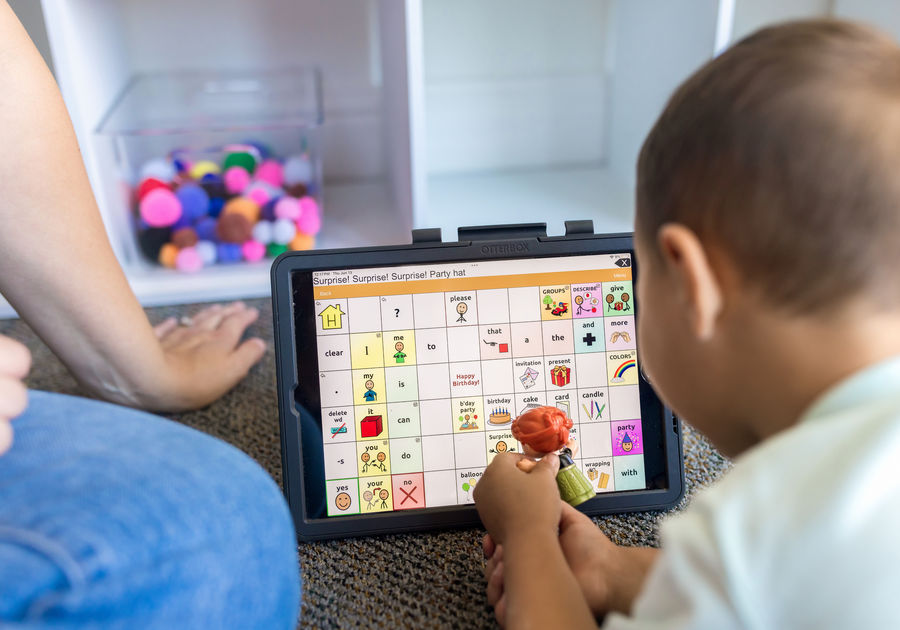Yay! Your child finally got access to an AAC device.
But...there's a catch--school and other therapy staff only want your kiddo to use the device to talk about what they want them to talk about. Here's the thing, THE ENTIRE POINT OF AN AAC DEVICE IS TO FIND OUT WHAT THE CHILD'S THOUGHTS AND NEEDS ARE!!!
The most frequent "tales" I receive about student's AAC device use from staff include the below:
- "They just press random buttons."
- "They just press the same button over and over again."
- "They don't press buttons related to the current activity. So I take their hand to make them press an icon that's related.""
- "They don't use it when they're upset and need to use it."
Here are my usual responses to all of these (feel free to steal them)
- "They just press random buttons."
How else are they going to learn how to use it? Think about when a child babbles and experiments with oral speech. They may say random sound and word combinations for a while before they refine speech. They have to learn how to use it somehow. Unless their communication partner is meticulously modeling each button on their AAC device vocabulary (which is highly unlikely).
LET THEM EXPLORE!!!
- "They just press the same button over and over again."
If they were using oral speech, they may also be repeating the words over and over again (think scripting, echolalia, etc.). If they were doing this, what would we do? We surely wouldn't take their voice away. Let them press buttons over and over. They are creating strong motor memory for those buttons. In my experience, this rarely takes away from the child using their device effectively. They can do both-- effectively communicate and stim or script. It could be regulating for them. Or, what we've heard from adult AAC users, sometimes their mind wants to share a message and they continue to say the wrong word over and over. They may be stuck in a loop. Should we punish them? No. Give them time. Be a patient communication partner.
Something I wish would happen more: have a second iPad with a matching vocabulary (you can easily airdrop vocabulary sets to another iPad with the same app). Then the communication partner could model something that the child could say, without taking the iPad away from them.
- "They don't press buttons related to the current activity. So I take their hand to make them press an icon that's related."
FOR THE LOVE OF GOD, DON'T TAKE A CHILD'S HAND AND FORCE THEM TO COMMUNICATE A CERTAIN MESSAGE.
For one, it's disrespectful. Secondly, it can cause some major prompt dependence. Lastly, many with complex communication need more time to complete a task with motor movements. Give them time to express a message. Maybe they press an unrelated message first, then after a couple of hits, they ultimately get to something related. Think about when you open up your phone and you originally intended to open up your email and respond to an email, then you accidentally opened up instagram and fifteen minutes later realize what you originally opened your phone for. Your strong motor plan took over and you accidentally went to instagram first. Hopefully you finally got back to sending that email.
Have some patience and grace.
Again: have a second iPad with a matching vocabulary (you can easily airdrop vocabulary sets to another iPad with the same app). Then the communication partner could model something that the child could say, without taking the iPad away from them.
- "They don't use it when they're upset and need to use it."
Well, yeah. It's hard to communicate when you're upset. I will tell you "use your words" is not the right thing to do or say when a child is in distress. This will not help them communicate more effectively. In fact, it may make them more upset and cause some negative associations with their AAC device. Especially if we are only offering it after they become upset.
Here's what I recommend doing instead:
Let's model some self-advocacy and protest words/phrases when the child is in a regulated state. This could look like acting out stressful situations with action figures, other toys--contriving situations to model what can be said in certain situations. Use video modeling and model self-advocacy and protest words/phrases. The child will be ready to learn in a more regulated state.
When they become upset, we can model on their device what they could say in that moment. But, we need to be wary of saying, "use your words," "tell me with your device," or shoving it in their face.
I will tell you that I am often met with confusion when I explain the above. However, I am hoping that eventually it will become more common knowledge and practice. For now, let's focus on increasing awareness of best and more respectful AAC practice.
If you need more support getting started with AAC for your child, reach out!
(209) 683-3427
mackenzie@communicationblooms.org



